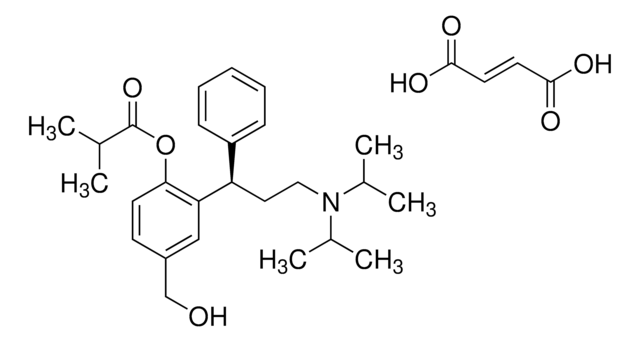SML1102
Darifenacin hydrobromide
≥98% (HPLC)
Sinónimos:
(3S)-1-[2-(2,3-Dihydro-5-benzofuranyl)ethyl]-α,α-diphenyl-3-pyrrolidineacetamide hydrobromide, UK 88525-04
About This Item
Productos recomendados
assay
≥98% (HPLC)
form
powder
optical activity
[α]/D +41 to +49°, c = 1 in methylene chloride
storage condition
desiccated
color
white to beige
solubility
DMSO: 20 mg/mL, clear
storage temp.
−20°C
SMILES string
O=C(N)C([C@H]1CN(CCC2=CC=C(OCC3)C3=C2)CC1)(C4=CC=CC=C4)C5=CC=CC=C5.Br
InChI
1S/C28H30N2O2.BrH/c29-27(31)28(23-7-3-1-4-8-23,24-9-5-2-6-10-24)25-14-17-30(20-25)16-13-21-11-12-26-22(19-21)15-18-32-26;/h1-12,19,25H,13-18,20H2,(H2,29,31);1H/t25-;/m1./s1
InChI key
UQAVIASOPREUIT-VQIWEWKSSA-N
Gene Information
human ... CHRM2(1129) , CHRM3(1131)
¿Está buscando productos similares? Visita Guía de comparación de productos
General description
Application
Biochem/physiol Actions
Features and Benefits
signalword
Warning
hcodes
Hazard Classifications
Eye Irrit. 2 - Skin Irrit. 2 - STOT SE 3
target_organs
Respiratory system
Storage Class
11 - Combustible Solids
wgk_germany
WGK 3
flash_point_f
Not applicable
flash_point_c
Not applicable
Certificados de análisis (COA)
Busque Certificados de análisis (COA) introduciendo el número de lote del producto. Los números de lote se encuentran en la etiqueta del producto después de las palabras «Lot» o «Batch»
¿Ya tiene este producto?
Encuentre la documentación para los productos que ha comprado recientemente en la Biblioteca de documentos.
Artículos
DISCOVER Bioactive Small Molecules for Neuroscience
Nuestro equipo de científicos tiene experiencia en todas las áreas de investigación: Ciencias de la vida, Ciencia de los materiales, Síntesis química, Cromatografía, Analítica y muchas otras.
Póngase en contacto con el Servicio técnico









